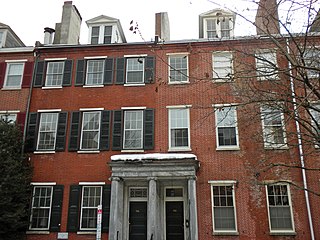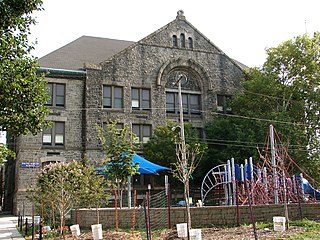
Washington Square West is a neighborhood in Center City, Philadelphia, Pennsylvania, United States. The neighborhood roughly corresponds to the area between 7th and Broad Streets and between Chestnut and South Streets, bordering on the Independence Mall tourist area directly northeast, Market East to the north, Old City and Society Hill to the East, Bella Vista directly south, Hawthorne to the southwest, and mid-town Philadelphia and Rittenhouse Square to the west. The area takes its name from Washington Square, a historic urban park in the northeastern corner of the neighborhood. In addition to being a desirable residential community, it is considered a hip, trendy neighborhood that offers a diverse array of shops, restaurants, and coffee houses. Washington Square West contains many gay-friendly establishments, especially in the gay village area of the neighborhood commonly known as the Gayborhood, which hosts annual events celebrating LGBT culture in Philadelphia, including OutFest.

Overbrook is an historic neighborhood that is located in the Commonwealth of Pennsylvania, United States. It is situated northwest of West Philadelphia, Philadelphia.

The Widow Maloby's Tavern is an historic, American tavern building that is located in the Queen Village neighborhood of Philadelphia, Pennsylvania.

The Lancaster Historic District, also known as Old Town Lancaster, is a national historic district that is located in Lancaster, Lancaster County, Pennsylvania.

The Henry George Birthplace is an historic home which is located in the Washington Square West neighborhood of Philadelphia, Pennsylvania.

William Strickland Row was a set of seven historic rowhouses, four of which survive.

Portico Row is a set of sixteen historic rowhouses located in the Washington Square West neighborhood of Philadelphia, Pennsylvania.

The Francis McIlvain House was a historic home, built in 1869, in the Logan Square neighborhood of Philadelphia. A 3+1⁄2-story brick rowhouse faced with ashlar brownstone, it had a mansard roof in the Second Empire style.

The Rafsnyder-Welsh House is an historic, American home that is located in the Rittenhouse Square East neighborhood of Philadelphia, Pennsylvania.

Ringgold Place is a set of 26 historical, American, rowhouses located in the Rittenhouse Square West neighborhood of Philadelphia, Pennsylvania.

The Ramcat Historic District, also known as the Schuylkill Historic District, is a national historic district that is located in the Rittenhouse Square West neighborhood of Philadelphia, Pennsylvania.

The Walnut–Chancellor Historic District is a national historic district that is located in the Rittenhouse Square West neighborhood of Philadelphia, Pennsylvania.

The Bache-Martin Elementary School is a pre-kindergarten to eighth grade school which is located in the Fairmount neighborhood of Philadelphia, Pennsylvania. It is part of the School District of Philadelphia. The school campus comprises two distinct buildings along 22nd Street, both of which were listed on the National Register of Historic Places in 1986.

The Nathaniel Irish House is an historic, American home that is located in the Queen Village neighborhood of Philadelphia, Pennsylvania.

Capt. Thomas Moore House is a historic home located in the Queen Village neighborhood of Philadelphia, Pennsylvania. It is located in between the Nathaniel Irish House, to the south, and Widow Maloby's Tavern, to the north. It was built in 1767, and is a 3+1⁄2-story, three bay brick rowhouse. This house is believed to have been built by Nathaniel Irish.

South Front Street Historic District is a national historic district located in the Queen Village neighborhood of Philadelphia, Pennsylvania. It encompasses seven contributing buildings, including the Nathaniel Irish House, Widow Maloby's Tavern, and Capt. Thomas Moore House, which are individually listed on the NRHP.

Drexel Development Historic District is a national historic district located in the University City neighborhood of Philadelphia, Pennsylvania. It encompasses 96 contributing rowhouses dated to the mid- to late-19th century. A number of the rowhouses were designed by architect Samuel Sloan. The architectural firm G. W. & W. D. Hewitt designed rowhouses for developer Anthony Joseph Drexel on the block bounded by Pine, new 39th, Baltimore, and 40th Streets. They are representative of a number of popular architectural styles including Second Empire, Italianate, and High Victorian.

The Girard Avenue Historic District is a national historic district which is located in the Cabot neighborhood of Philadelphia, Pennsylvania, United States.

Callowhill Industrial Historic District is a national historic district located in the Callowhill neighborhood of Philadelphia, Pennsylvania. It encompasses 31 contributing buildings, 1 contributing site, and 1 contributing structure. The commercial and industrial buildings were mostly built from the 1890s through the 1930s. They range from 4 to 14 stories in height and the exteriors are of brick, concrete, terra cotta, and stone. Most of the buildings are characterized as box-shaped, mid-rise loft buildings with flat roofs. Also in the district are eleven 2+1⁄2-story brick rowhouses, with the earliest dated to the 1830s. Notable buildings include the Rebman Building (1903), Stewart Cracker Building, U.S. Tire Company Building (1911), Lasher Building (1927), Philadelphia City Morgue (1928), and Overland Motor Company Building. Located in the district and listed separately are the Smaltz Building (1912), Terminal Commerce Building, Goodman Brothers and Hinlein Company, and the Packard Motor Corporation Building.

The Lower North Philadelphia Speculative Housing Historic District, also known as the Cecil B. Moore Redevelopment Area, is a national historic district located in the North Central neighborhood of Philadelphia, Pennsylvania.

























